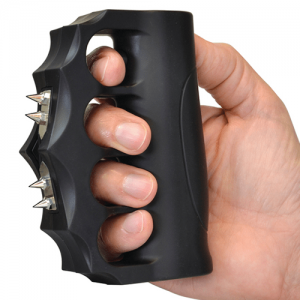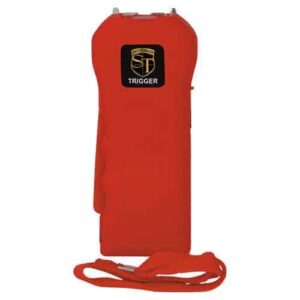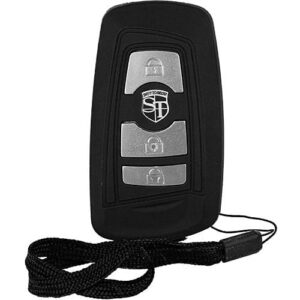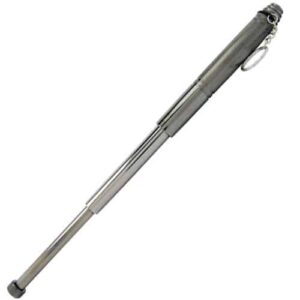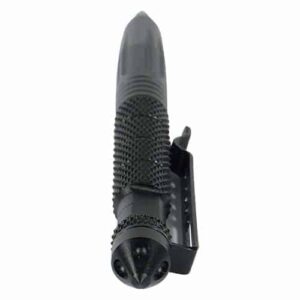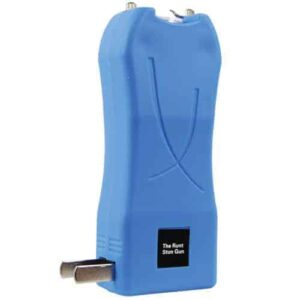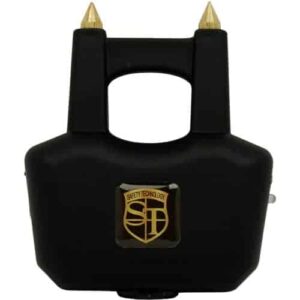Imagine feeling safe and confident as you walk down a dark alley or navigate through a crowded city street. With “The Power of the Tazor: A Guide to Self-Defense,” you can arm yourself with the knowledge and skills necessary to protect yourself in any situation. Discover the incredible potential of this compact and innovative device, and learn how it can empower you to take control of your personal safety. Whether you’re a seasoned martial artist or a complete beginner, this article will show you how the Tazor can become your trusted companion in the journey to self-defense mastery. So, let’s embark on this empowering adventure together, and unlock the hidden power within you.
Table of Contents
ToggleUnderstanding the Tazor
What is a Tazor?
A Tazor, also known as a Taser, is a handheld device designed for self-defense purposes. It uses electrical current to temporarily immobilize a target, making it an effective non-lethal alternative to traditional firearms. The Tazor is widely used by law enforcement agencies as well as individuals who are looking for a reliable way to protect themselves.
How Does a Tazor Work?
A Tazor works by delivering an electric shock to the target, causing pain and muscle contractions that result in temporary incapacitation. The device operates by using compressed nitrogen to propel two probes attached to insulated wires towards the target. These probes then attach to the target’s clothing or skin, enabling the electric current to flow through their body. The electrical pulses interrupt the communication between the brain and muscles, temporarily immobilizing the target.
Different Types of Tazors
There are several different types of Tazors available in the market, each with its own unique features and capabilities. One common type is the “contact stun” Tazor, which requires direct contact with the target to deliver the electric shock. Another type is the “conducted energy weapon” Tazor, which uses wired probes to deliver the shock from a distance. Additionally, there are Tazors specifically designed for civilian use, as well as models intended for law enforcement and military personnel.
Legal Considerations
Before purchasing and using a Tazor, it is important to understand the legal considerations associated with its usage. While laws may vary between different jurisdictions, possessing a Tazor for self-defense purposes is generally legal in many countries. However, it is crucial to research and comply with local laws and regulations regarding Tazor ownership, concealed carry permits, and restrictions on public usage. Misuse of the Tazor can have legal consequences, so it is essential to familiarize yourself with the laws to ensure proper and lawful usage.
Benefits of Using a Tazor
Non-Lethal Self-Defense
One of the primary benefits of using a Tazor for self-defense is its non-lethal nature. Unlike firearms, which have the potential to cause serious injury or death, a Tazor allows you to protect yourself without risking the same level of harm to your attacker. This can provide peace of mind, knowing that you have a means of self-defense that minimizes the likelihood of fatal consequences.
Effective at Close Range
Tazors are particularly effective at close range encounters, where physical contact with an attacker may not be a viable option. The ability to incapacitate an assailant from a safe distance provides a significant advantage, allowing you to create space and potentially escape from a dangerous situation. This feature makes the Tazor an excellent tool for personal safety, especially in scenarios where physical strength or skill may be overpowered.
Easy to Use
Another advantage of Tazors is their ease of use. They are designed to be user-friendly and require minimal training to operate effectively. Most Tazors have simple activation buttons or switches, making them accessible even in high-stress situations. Additionally, their compact and portable design allows for easy carry and quick deployment, ensuring that you can access your self-defense tool when needed.
Psychological Advantage
Beyond their physical effects, Tazors provide a psychological advantage in self-defense situations. The sight and sound of a Tazor being deployed can act as a deterrent to potential attackers, as they understand the potential consequences of engaging with someone armed with a Tazor. The presence of a Tazor can help de-escalate a situation, potentially reducing the need for physical confrontation.
Key Features to Consider
Voltage and Power
When considering which Tazor to purchase, it is important to assess the voltage and power output. Higher voltage Tazors generally deliver stronger electric shocks, increasing the likelihood of effective immobilization. However, it is essential to strike a balance between power and safety to ensure that the Tazor does not cross into dangerous territory.
Range and Accuracy
The range and accuracy of a Tazor are crucial factors to consider, especially in situations where you may need to immobilize an attacker from a distance. Tazors with longer ranges allow you to maintain a safe distance, reducing the likelihood of physical harm. Additionally, models with better accuracy ensure that the probes make proper contact with the target, maximizing the effectiveness of the electric shock.
Size and Portability
For everyday carry and easy accessibility, the size and portability of a Tazor are essential considerations. Compact and lightweight Tazors are ideal, as they can be easily concealed or carried in a bag or pocket without hindering your movements. The more comfortable you are with carrying your Tazor, the more likely you’ll have it readily available when needed.
Battery Life and Rechargeability
Reliable battery life is crucial for a self-defense tool like a Tazor. Ensuring that your Tazor has a long-lasting battery or rechargeable options is vital to avoid unexpected power failures. Regularly check the battery charge and consider carrying a spare battery or having a charging method readily available to ensure the Tazor is always operational.
Additional Safety Features
Some Tazors come equipped with additional safety features that can enhance your overall experience. These features may include safety locks or indicators to prevent accidental discharges, built-in flashlight functionality for improved visibility, or safety switches that require deliberate activation to prevent unauthorized use. Evaluating these additional features can help you choose a Tazor that aligns with your specific needs and preferences.
Proper Handling and Technique
Familiarize Yourself with the Tazor
Before using a Tazor for self-defense, it is crucial to familiarize yourself with its operation and features. Read the user manual thoroughly and practice handling the Tazor in a safe and controlled environment. Understanding the device’s functionality, safety mechanisms, and proper procedures will help avoid accidents and ensure effective use when the need arises.
Hold and Carry the Tazor Correctly
Properly holding and carrying the Tazor is essential for quick and effective deployment. Familiarize yourself with the recommended grip and always keep your finger off the activation button or switch until you are ready to use it. Practice drawing the Tazor from its holster or storage location to build muscle memory and increase your speed and accuracy in high-pressure situations.
Aim and Fire with Precision
When using a Tazor, accuracy is key. During training, practice aiming at specific targets to develop accurate muscle memory. Aim for larger muscle groups such as the torso, thigh, or back to increase the likelihood of effective immobilization. Remember to keep a steady hand and maintain focus on your target to maximize the effectiveness of the electric shock.
Understanding Effective Striking Points
Understanding the body’s effective striking points is crucial for using a Tazor effectively. The primary targets for effective immobilization are major muscle groups, the upper and lower torso, and areas where the electric current can pass effectively. These areas include the abdomen, lower back, upper thighs, and shoulders. Aim for these target areas to inflict the greatest temporary incapacitation on an attacker.
Using the Tazor for Self-Defense
Assessing the Threat Level
Before deploying a Tazor in self-defense, it is crucial to assess the threat level accurately. Evaluate the situation and determine the intent and capability of the potential attacker. Only use the Tazor as a last resort when you believe that there is an imminent threat to your safety and non-lethal force is necessary. Proper threat assessment can help prevent unnecessary escalation of the situation.
Maintaining Distance and Creating Space
Creating distance between yourself and an attacker is essential for personal safety. If faced with a potential threat, try to maintain a safe distance to minimize the risk of physical harm. When possible, create space between yourself and the attacker by using verbal commands, assertive body language, or physical barriers. Maintaining distance allows you more time to react and potentially avoid physical confrontation altogether.
Effective Deployment Techniques
When deploying a Tazor in a self-defense situation, it is crucial to act decisively and effectively. Practice deploying your Tazor quickly and efficiently, ensuring proper aim and probe placement. Maintain a firm grip on the device and activate it according to the manufacturer’s instructions. Effective deployment techniques can increase the chances of successfully immobilizing an attacker and creating an opportunity to escape.
Disabling an Attacker
The primary objective of using a Tazor in self-defense is to immobilize the attacker temporarily, giving you a chance to escape or seek help. After successfully deploying the Tazor, be prepared to disengage and move away from the attacker. Avoid physical contact or further confrontation, as it is essential to prioritize your safety and seek assistance when necessary.
Escape and Seek Help
Once the attacker has been temporarily immobilized, it is crucial to escape from the situation as quickly as possible. Create distance between yourself and the attacker and seek a safe location. Contact law enforcement or emergency services immediately to report the incident and provide them with accurate details of the situation. Though the Tazor is an effective self-defense tool, remember that your ultimate goal is to ensure your safety and well-being.
Tazor Maintenance and Care
Cleaning and Storage
Proper maintenance and care are essential to ensure the longevity and reliability of your Tazor. Regularly clean the device using a soft cloth to remove any dirt or debris that may accumulate. Avoid using abrasive materials or cleaning agents that could damage the Tazor’s components. Store the Tazor in a cool, dry place away from any extreme temperatures or moisture to prevent damage and maintain its functionality.
Regular Battery Checks
To ensure that your Tazor is always ready for use, perform regular battery checks. Test the battery life periodically, especially before important outings or trips. Follow the manufacturer’s guidelines for battery replacement or recharging to maintain the Tazor’s full power capacity. Remember that a fully charged Tazor is crucial for effective self-defense, so make battery checks a routine part of your maintenance regimen.
Checking and Replacing Cartridges
Tazors use cartridges containing the probes and wires necessary to deliver the electric shock. Regularly inspect the cartridge, ensuring that it is securely attached and free from any damage or defects. Follow the manufacturer’s instructions for replacing the cartridge when needed. Maintaining reliable cartridges is crucial, as damaged or defective ones may impair the Tazor’s effectiveness.
Training and Certification Renewal
Proper training and certification are vital for responsible and effective Tazor usage. Seek out approved training programs or certified instructors to learn proper handling techniques, deployment strategies, and laws governing Tazor usage in your area. Regularly renew your certification to stay up-to-date with the latest practices and legal requirements. Responsible training and certification will help ensure that you are well-prepared and knowledgeable about using a Tazor safely and effectively.
Legal Aspects of Tazor Usage
Researching Local Laws and Regulations
Before purchasing and using a Tazor, it is essential to research and understand the local laws and regulations regarding its usage in your jurisdiction. Laws surrounding Tazors can vary significantly, so familiarize yourself with the specific rules governing possession, carry permits, and usage restrictions in your area. Complying with the law is crucial to avoid legal consequences and promote responsible Tazor ownership and usage.
Understanding Justifiable Use of Force
Knowing the legal standards for justifiable use of force is crucial when using a Tazor for self-defense. Generally, the use of force is considered justifiable if you reasonably believe there is an imminent threat of harm to yourself or others. However, laws may vary, so understanding the specific criteria for justifiable force in your jurisdiction is essential. Consult legal professionals or resources to ensure you are well-informed about the legal aspects of using a Tazor in self-defense.
Concealed Carry and Public Usage
Concealed carry laws regarding Tazors can vary between jurisdictions. In some places, carrying a Tazor concealed may require a specific permit similar to firearms. Other areas may allow open carry without restrictions. Understand the laws regarding concealed carry and public usage to ensure compliance and avoid legal issues. Remember that responsible and lawful usage is crucial for the overall acceptance and accessibility of Tazors as self-defense tools.
Restrictions and Limitations
While Tazors are generally legal for self-defense purposes, there may be restrictions or limitations on their usage in certain circumstances. For example, certain locations such as airports, government buildings, or schools may have policies prohibiting the possession or use of Tazors. Additionally, restrictions on the use of Tazors against vulnerable populations such as children or the elderly may exist. Familiarize yourself with these restrictions and limitations to ensure your usage of the Tazor remains within legal boundaries.
Legal Consequences of Misuse
Misuse or improper usage of a Tazor can have severe legal consequences. It is essential to understand that using the device irresponsibly, such as deploying it unnecessarily or for non-defensive purposes, can result in criminal charges. Additionally, using the Tazor in a manner that causes serious injury or harm may lead to legal repercussions. Always prioritize safety, adhere to the law, and understand the potential consequences of misusing a Tazor.
Alternative Self-Defense Options
Pepper Spray
Pepper spray is a widely used alternative to Tazors for self-defense. It contains a chemical compound that causes temporary blindness, difficulty breathing, and intense pain, providing an opportunity to escape or seek help. Pepper spray is compact, easy to use, and legal in many jurisdictions. However, it requires close proximity to the target and may not be as effective against individuals under the influence of drugs or alcohol.
Stun Guns
Stun guns are another alternative for self-defense, delivering a high-voltage electric shock upon contact with the target. Unlike Tazors, stun guns require direct contact to immobilize an attacker. Stun guns are compact and portable but may require physical strength to use effectively. It is important to research and understand the legalities surrounding stun guns in your area before considering them as a self-defense option.
Personal Alarms
Personal alarms are small devices that emit a loud, attention-grabbing sound when activated. They act as a deterrent, drawing attention to a potential threat and potentially scaring off attackers. Personal alarms are easy to carry, require minimal training, and are legal in most jurisdictions. However, they may not physically incapacitate an attacker and are primarily used to alert others to the situation.
Self-Defense Classes
Self-defense classes teach physical techniques and strategies to defend oneself effectively. These classes provide training in techniques such as striking, grappling, and situational awareness. Learning self-defense techniques can increase your confidence and ability to protect yourself in various situations. These classes often emphasize non-lethal strategies and avoidance, giving you the tools to assess and react appropriately to potential threats.
Training and Preparedness
Choosing a Reputable Trainer or Program
When considering self-defense training, it is crucial to choose a reputable trainer or program. Look for certified instructors or programs with a proven track record and positive reviews. Proper training ensures that you learn effective techniques and understand the legal and ethical aspects of self-defense. Research multiple options, speak with instructors, and choose a program that aligns with your goals and values.
Physical Fitness and Conditioning
Maintaining physical fitness and conditioning is essential for self-defense readiness. Regular exercise and strength training can improve your stamina, speed, and agility, increasing your ability to respond effectively in a threatening situation. Incorporate exercises that enhance core strength, cardiovascular endurance, and flexibility to prepare yourself physically for potential self-defense scenarios.
Developing Awareness and Alertness
Developing awareness and alertness is a crucial aspect of self-defense preparedness. Pay attention to your surroundings, practice situational awareness, and trust your instincts. Recognizing potential threats and avoiding dangerous situations whenever possible are key elements of self-defense. Stay alert, avoid distractions, and maintain focus on your environment and the people around you.
Staying up-to-date with Self-Defense Techniques
Self-defense techniques and strategies evolve over time, so staying up-to-date with the latest practices is essential. Engage in continuous learning by attending seminars, workshops, or advanced training sessions. Read books or articles written by experts in the field or follow reputable self-defense websites or blogs. Staying informed and regularly refreshing your knowledge empowers you with the most effective self-defense methods.
Conclusion
Embracing Personal Safety
Personal safety should be a top priority for everyone, and understanding the importance of self-defense tools like the Tazor is vital. By embracing personal safety, you take an active role in protecting yourself and others from potential harm. The Tazor offers a non-lethal and effective means of self-defense, providing peace of mind and a sense of empowerment.
Choosing the Right Self-Defense Method
When choosing a self-defense method, consider your individual needs, preferences, and legal requirements. Evaluate the benefits and limitations of each option, such as the Tazor, pepper spray, stun guns, personal alarms, or self-defense classes. Select a method that aligns with your comfort level, lifestyle, and the level of protection you desire.
Taking Control of Your Security
Ultimately, taking control of your security is about being prepared and proactive. Research local laws and regulations, seek proper training, and stay informed about self-defense techniques. Cultivate a mindset of awareness and preparedness while maintaining physical fitness. By taking these steps and understanding the options available to you, you can empower yourself to stay safe and protect those around you.


